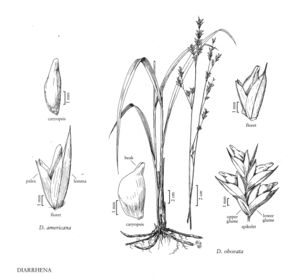Difference between revisions of "Diarrhena americana"
FNA>Volume Importer |
imported>Volume Importer |
||
| (4 intermediate revisions by 2 users not shown) | |||
| Line 4: | Line 4: | ||
|publications= | |publications= | ||
|common_names=American beakgrain | |common_names=American beakgrain | ||
| + | |special_status={{Treatment/ID/Special_status | ||
| + | |code=E | ||
| + | |label=Endemic | ||
| + | }} | ||
|basionyms= | |basionyms= | ||
|synonyms= | |synonyms= | ||
| Line 17: | Line 21: | ||
-->{{Treatment/Body | -->{{Treatment/Body | ||
|distribution=Md.;Ark.;Okla.;Ohio;Mo.;N.C.;Mich.;Ala.;Tenn.;W.Va.;Va.;Ill.;Ga.;Ind.;Ky. | |distribution=Md.;Ark.;Okla.;Ohio;Mo.;N.C.;Mich.;Ala.;Tenn.;W.Va.;Va.;Ill.;Ga.;Ind.;Ky. | ||
| − | |discussion=<p>Diarrhena americana is restricted to the United States, where it grows in rich, moist woods from Missouri to Maryland and south to Oklahoma and Alabama. Its range is primarily to the east of the range of D. obovata.</p> | + | |discussion=<p><i>Diarrhena americana</i> is restricted to the United States, where it grows in rich, moist woods from Missouri to Maryland and south to Oklahoma and Alabama. Its range is primarily to the east of the range of <i>D. obovata</i>.</p> |
|tables= | |tables= | ||
|references= | |references= | ||
| Line 26: | Line 30: | ||
-->{{#Taxon: | -->{{#Taxon: | ||
name=Diarrhena americana | name=Diarrhena americana | ||
| − | |||
|authority=P. Beauv. | |authority=P. Beauv. | ||
|rank=species | |rank=species | ||
| Line 33: | Line 36: | ||
|basionyms= | |basionyms= | ||
|family=Poaceae | |family=Poaceae | ||
| − | |illustrator=Linda | + | |illustrator=Linda Ann Vorobik;Hana Pazdírková |
| + | |illustration copyright=Utah State University | ||
|distribution=Md.;Ark.;Okla.;Ohio;Mo.;N.C.;Mich.;Ala.;Tenn.;W.Va.;Va.;Ill.;Ga.;Ind.;Ky. | |distribution=Md.;Ark.;Okla.;Ohio;Mo.;N.C.;Mich.;Ala.;Tenn.;W.Va.;Va.;Ill.;Ga.;Ind.;Ky. | ||
|reference=None | |reference=None | ||
|publication title= | |publication title= | ||
|publication year= | |publication year= | ||
| − | |special status= | + | |special status=Endemic |
| − | |source xml=https:// | + | |source xml=https://bitbucket.org/aafc-mbb/fna-data-curation/src/200273ad09963decb8fc72550212de541d86569d/coarse_grained_fna_xml/V24/V24_73.xml |
|subfamily=Poaceae subfam. Pooideae | |subfamily=Poaceae subfam. Pooideae | ||
|tribe=Poaceae tribe Diarrheneae | |tribe=Poaceae tribe Diarrheneae | ||
Latest revision as of 16:25, 11 May 2021
Culms 60-131 cm, glabrous or pubescent. Sheaths often pubescent; collars usually pubescent; auricles pubescent; ligules 0.5-1.8 mm; blades 25-51 cm long, 7-20 mm wide, glabrous or scabridulous on both surfaces, margins scabridulous or ciliate. Panicles 9-30 cm, with 4-23 spikelets. Spikelets 10-20 mm, oblong to elliptic, with (2)4-5(7) florets. Glumes green to stramineous; lower glumes 1.7-4.2 mm long, 0.3-0.7 mm wide in profile, (1)3(5)-veined; upper glumes 2.8-6.4 mm long, 0.6-1.2 mm wide in profile, (3)5-veined; calluses pubescent on all but the lowest mature lemma; lemmas (3.8)5.3-10.8 mm, widest below the middle, lanceolate in profile, tapering gradually, apices sharply cuspidate; paleas glabrous or scabridulous, apices usually bifid, sinuses to 0.7 mm deep; anthers (1.7)2-2.9(3.5) mm. Caryopses 4.6-5.8 mm long, 1.3-1.8 mm wide, narrowly lanceolate in outline, gradually tapering to a blunt beak, wrinkled or smooth, usually blackish-brown to black, except for the straw-colored beak, rarely orange-brown. 2n = unknown.
Distribution
Md., Ark., Okla., Ohio, Mo., N.C., Mich., Ala., Tenn., W.Va., Va., Ill., Ga., Ind., Ky.
Discussion
Diarrhena americana is restricted to the United States, where it grows in rich, moist woods from Missouri to Maryland and south to Oklahoma and Alabama. Its range is primarily to the east of the range of D. obovata.
Selected References
None.
